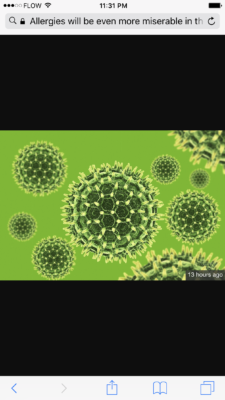Published 10 April 2017
Yay
It’s spring in California: the birds are chirping, the flowers are blooming, and my sinuses are so swollen they might just pop right out of my face.
I’m one of the 36 million or so Americans lucky enough to suffer from seasonal allergies. And experts tell me that I might suffer from this eye-itching, sinus-pounding misery even more in the future. Warming global temperatures may lead to longer blooming seasons, and rising CO2 levels could help weeds and trees grow more, and faster. That could mean more allergy-causing pollen, according to a growing crop of studies. This is especially bad news for people with allergic asthma, who can suffer from life-threatening attacks.
Seasonal allergies, also known as hay fever, are about sex — plant sex, that is. To reproduce, many (but not all) plants need to transfer pollen from the male plant onto a female flower. Some rely on pollinators like bees for this. “But some plants want to do it on the cheap, and they have the wind pollinate,” Lewis Ziska, a plant biologist with the US Department of Agriculture, tells The Verge. The problem is that wind pollination is not very efficient, Ziska says. So, some plants like ragweed have to pump out a billion-odd grains of pollen to ensure that a few land on a female flower.
In the spring, trees are the plants getting busy. In the summer, it’s grasses and weeds. In the fall, ragweed. For seasonal allergy sufferers like me, all this pollen stimulates the immune system, which recognizes innocuous pollen proteins as dangerous invaders. That makes immune cells pump out molecules that cause itchiness and swelling, like histamine — the molecule blocked by over-the-counter allergy medications like Benadryl. The result is itchy eyes, runny noses, a scratchy throat, and, in severe cases, constricted airways.
There are a couple of different ways that a changing climate could worsen allergies. Plants absorb carbon dioxide to make fuel via photosynthesis, so the idea is that more CO2 in the air means more food for the plants. That could lead to more plant growth — and more pollen. (Obviously, there are many other effects of climate change that are massively damaging to plants, like wildfires or extreme weather events.)
Rising CO2 levels are also causing global temperatures to rise, especially at higher latitudes, Charles Schmidt reports for Environmental Health Perspectives. This appears to be lengthening the growing season — allowing plants to make more pollen for longer periods of time.
All this could affect ragweed, a flowering plant that’s a main cause of hay fever. Scientists found that ragweed grown in the lab flowers more and produces more pollen when carbon dioxide levels go up. These results were observed out of the lab, too, in a little microcosm of global warming known as a city. There’s about 30 percent more carbon dioxide in the atmosphere of downtown Baltimore than in nearby rural areas — and it’s about 3 degrees warmer, too. Ragweed grown in the downtown Baltimore plot thrived, growing bigger and puffing out larger plumes of pollen than its country counterpart.
Across the pond, in Europe, scientists led by Michelle Epstein at the University of Vienna also modeled ragweed’s expanding range and increasing pollen production. They calculate that by 2060, the number of Europeans suffering from ragweed-induced hay fever could double to 77 million.

Since it’s spring, ragweed isn’t the plant that’s making me miserable right now: trees are. And the picture is a little more complicated for trees. Depending on the species and the location, warmer spring temperatures can make a tree flower earlier or later, less or more. In some regions, like Denmark and Switzerland, pollen counts for certain species do seem to be rising along with spring temperatures. Oak and birch trees appear to be flowering earlier. And pine trees grown in an experimental site with higher CO2 levels released more pollen than trees grown under normal conditions. Birch trees grown in warmer temperatures also appear to produce more of a specific protein that’s especially allergenic. That means that these trees aren’t just producing pollen longer — they’re producing more potent pollen, too.
Still, nothing is set in stone. Ziska and his colleague Paul Beggs in Australia note in a 2012 review paper that there’s a lot left to learn about how warming temperatures and climbing carbon dioxide emissions will change trees’ pollination practices. One thing’s for sure: as temperatures continue to break records worldwide, I’m going to keep stocking up on antihistamines — just in case the apocalypse hits and the Benadryl, Allegra, and Claritin factories all go out of service.






